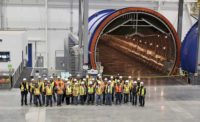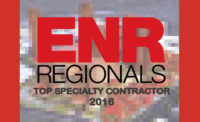Working in Arizona for nearly four decades, Sun Valley Masonry has built a successful portfolio of projects big and small, complex and simple. A recent growth spurt—which has driven revenue to $61.7 million in 2015, an increase of more than 70% from 2013—has made the firm one of the largest subcontractors in the region as ranked by ENR Southwest’s Top Specialty Contractors survey.
Company leadership says the rising returns directly relate to its philosophy of performing precision workmanship, keeping a keen eye on safety and being a reliable partner to clients.
According to Ian McDowell, project manager with Sundt, such qualities make Sun Valley Masonry a key collaborator.
“Sun Valley Masonry is our go-to contractor for some of the most difficult masonry projects we perform,” he says. “If the projects are large, they have it covered. If the projects are unique and include innovative materials, they are a great partner. They can even rightsize so that they are competitive on smaller work.”
The company began when Kenneth Nessler moved to Phoenix from Illinois in 1977, armed with a new box of business cards and a packet of legal pads. But its foundational partnership came when Nessler’s friend and partner, Robert Baum, joined him in Phoenix to run field operations in 1981. Fast-forward to the present, and the firm employs more than 400, is part of some of the most high-profile projects in Arizona and is able to maintain small-job scalability. The firm, which is being led by the next generation of family members, has also successfully transitioned to become more of a regional player, with offices in Tucson and Stillwater, Okla.
While Baum and Nessler remain involved to offer guidance, sons Todd Nessler and Todd Baum, vice presidents, along with Baum’s cousin, CFO David Beer, now run the privately held, limited-ownership firm.
Work Matters
Sun Valley built its reputation as a firm that could perform masonry construction faster than its competitors while maintaining quality, says Todd Nessler. That foundation was first laid when Sun Valley built Borgata in Scottsdale, Ariz., in the early 1980s. The retail-inspired duplicate of the Italian town of San Gimignano was not just a tough technical job for a masonry firm to recreate with modern materials, but it also had a very aggressive time line.
“From that point forward, it gave us a badge in the marketplace,” Nessler says.
Over the course of the next three decades, the company founders took that badge and ran with it. “My dad had his foot on the gas pedal, and Robert had the steering wheel,” he says. “That really set the foundation and culture.”
While some may contend that not much has changed in masonry in centuries, Nessler says the expectation of job safety and exacting precision has changed the way the firm approaches its work.
“Safety is such a huge element for us,” Todd Baum says. “We lay out scaffold plans and what types we are using. On some jobs we are going 250 feet in the air.”
The firm’s 0.60 EMR has improved in recent years, partly due to the formation of safety committees comprising field personnel and management as well as random job walks.
“We are trying to build a culture of safety. Whether it is a Circle K or Arizona State University’s football stadium, we’ve had to build that culture. On the high profile jobs, it is easier to be safe. It is a focus, and it is demanded. On smaller projects, it is more difficult,” Baum says.
Times Change
Nearly every firm has faced the reality of vanishing backlogs and dwindling revenue during the recent economic downturn. Sun Valley was no exception. The firm rode out the challenge by adapting to new market conditions and finding work in Oklahoma, where they now have a permanent presence. The move was precipitated by work done for Holder Construction, a fast-growing general contractor in the state.
“Oklahoma was a blessing for us. It was slow here,” says Nessler.
Expanding into a new geographic area rekindled notions Sun Valley Masonry has held dear since they were applied by its founders: Walk before you run and provide great service.
“We’re a subcontractor. We need to stay within ourselves. We can’t take on too much work and have too much equipment. We are about service, and if we can’t give [clients] that service, we have a problem,” Baum says.
More recently, the firm has diversified into concrete work, including foundations, slab-on-grade, structural, cast-in-place, podium decks and tilt panels. The concrete work grows at an intentionally deliberate pace and is in the “walk” phase, according to Nessler.
The elder Baum and Nessler also put the finishing touches on their nearly 20-year succession plan over the last five years.
The economic downturn coincided with changing dynamics on how the firm acquires work, especially with the rise of CMAR and design-build as traditional hard-bid jobs waned.
“Relationships became more important than just the product. Dave [Beer] was the one who recognized it and strove to make Sun Valley a leader in that,” Nessler says.
Beer says that while he enjoys his “bean-counting” role as CFO, cultivating relationships is also gratifying.
“It may sound cliché, but we sell services. The masonry and concrete work is a by-product,” he says.
As with many construction firms in today’s marketplace, Sun Valley endeavors to assist and consult during a project’s design phase while embracing on-field technologies to get work done faster. But in the end, Nessler says Sun Valley has found success with a team approach that places heavy emphasis on satisfied clients.
“Our leadership model is different than most. We really work for our employees. It’s our job and our role to facilitate them in getting their job done. It’s not a hierarchy. We are a big team, and we all have our roles and skill sets,” he says.






Post a comment to this article
Report Abusive Comment